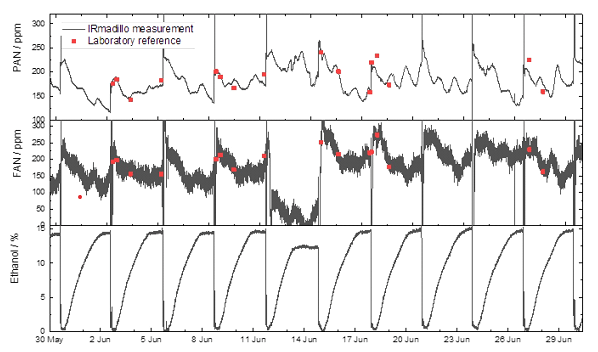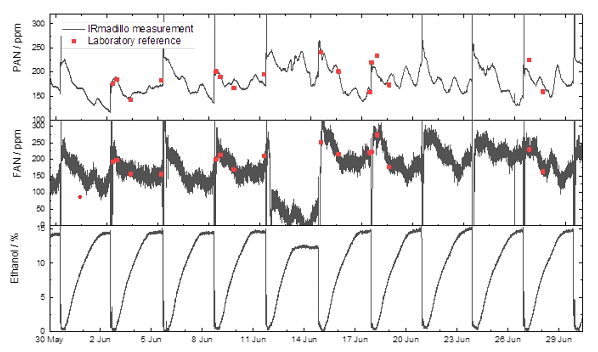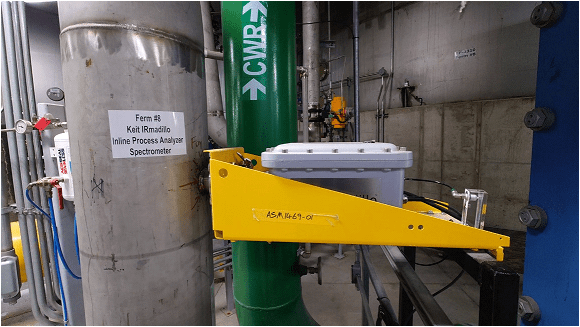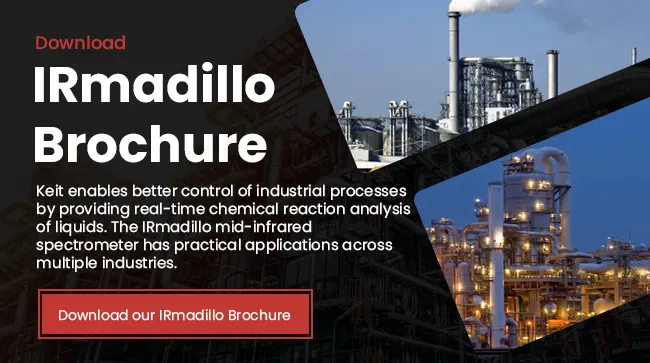
Real-Time FAN And PAN Measurement In Fuel Ethanol Fermentation
Introduction
Fuel ethanol fermentation is a complex biological process where complex sugars and carbohydrates are broken down by enzymes, providing food for yeast to ferment into ethanol. Yeasts need more than just sugars to be productive, however, and balancing these needs against the costs of running the plant is a key challenge for any refinery manager and process operator.

HPLC measurements can give a glimpse into the yeast’s state through glycerol levels, but by the time a glycerol spike is noticed it is probably too late to resolve the issue causing it.
Spectrometers allow continuous and detailed measurement of chemical concentrations in real time. The majority of process spectrometers are based on near infrared light, which is fundamentally less informative then mid infrared light. Conventional mid infrared spectrometers (which often use a Fourier transform and so are referred to as "FTIR spectrometers") have sensitive moving parts and fragile fiber probes – making them wholly unsuitable for production environments such as ethanol refineries.
The IRmadillo is a process analyzer built using FTIR spectroscopy, but with static optics, removing the need for moving mirrors or fiber probes, and dramatically improving stability, reliability, and ruggedness.
Example Use Case
This application note presents data collected at an ethanol refinery in Iowa, measuring the FAN (freely available nitrogen) and PAN (primary amino nitrogen) levels of the fermentation for a month. By measuring the FAN and PAN levels the customer can start to control the addition of urea, ammonia or other nitrogen source to ensure the process sits in the sweet spot of enough nitrogen for “happy yeast” but minimum costs to the plant.
After the instrument was installed, the customer was able to measure FAN and PAN in real time, compare the difference between the two, and spot low nitrogen issues early enough to resolve them.
Results
The instrument had already been calibrated to measure ethanol (as part of the “real time HPLC” approach to calibration – see our other app note APN1009 for more information), and additional models for FAN and PAN were built using laboratory data from Foundation Laboratories. The measurement performance for FAN and PAN is:
⦁ FAN average error = 20 ppm
⦁ PAN average error = 17 ppm
These numbers are well within a usable range, and can be used to both understand and also control the process. There are some very interesting and useful results apparent in the fermentations studied in this example (see the figure).

Figure 1: Measurements of ethanol, PAN and FAN in real-time for a month long experiment, with associated laboratory reference data provided by Foundation Laboratories
Firstly, the PAN values do not overlay perfectly with FAN, meaning the nitrogen balance does change within the fermentation. The PAN values change significantly through the batch, suggesting a lot of biochemical activity that is not visible by HPLC sampling alone.
Secondly, the FAN values clearly show the batch starting with high nitrogen that is consumed through the fermentation. But most importantly, there is a clear link between low FAN and a poor batch – that only achieved 12 % ethanol instead of the 15 % typically achieved. This clearly highlights how if the customer had been using the IRmadillo at the time they could have adjusted the FAN value and saved that batch – with significant impact on profitability and revenue.

Figure 2: IRmadillo instrument installed in a recirculation line
Conclusions
This work has shown that the IRmadillo spectrometer is easy to install into a recirculation line on the fermenter, and can be calibrated to become a continuous, in situ and real-time nitrogen meter (along with a real-time HPLC style meter). The measurement of FAN in particular could prevent failed or sub-par batches, where there is a clear relationship between low FAN and low ethanol output – something that would not have been evident in glycerol measurements until much later. The return on investment for the IRmadillo could potentially have been obtained in that single batch – let alone any future issues.
Keep In Mind
The IRmadillo can be calibrated to measure a large range of chemicals at the same time. This work shows the use for PAN, FAN, and ethanol measurement, but it can also be calibrated to measure DP4+, DP3, DP2, dextrose, lactic and acetic acids, glycerol and fusels – all at the same time, in real-time.
The IRmadillo is a mid-infrared analyzer, not a near infrared (NIR) analyzer. NIR is a fundamentally different technology that is not suitable for applications with high solids loading (such as corn mash), that also struggles differentiating between similar molecules (such as DP4, DP3 and DP2).

